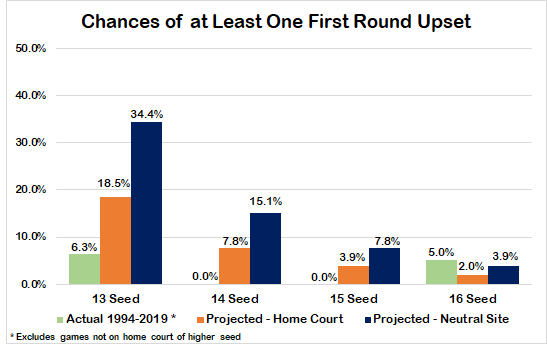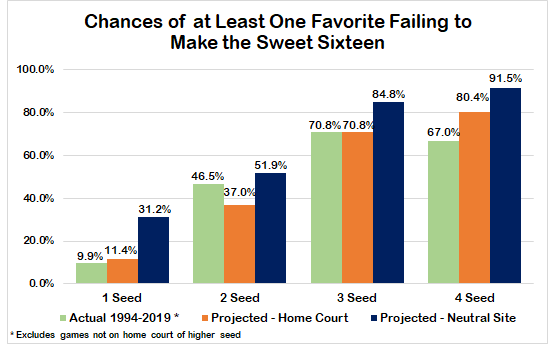So, You’re Telling Me There’s a Chance
Analyzing the increased likelihood of upsets in this year’s NCAA tournament
Thanks for reading the Her Hoop Stats Newsletter. If you like our work, be sure to check out our stats site, our podcast, and our social media accounts on Twitter, Facebook, and Instagram. You can also buy Her Hoop Stats gear, such as laptop stickers, mugs, and shirts!
Haven’t subscribed to the Her Hoop Stats Newsletter yet?
If I conducted a Family Feud-style poll asking basketball fans why they love March Madness, responses such as exciting buzzer-beating finishes, cheering for your alma mater, and claiming victory in your office pool would make the top ten. And while game-winning shots by Morgan William, Arike Ogunbowale, and Charlotte Smith have certainly made for some must-see-TV over the years, I am willing to wager that Steve Harvey would reveal upsets as the number one answer in this hypothetical poll.
America loves an underdog, and there are few things as thrilling in the sports world as a mid-major school rising to the occasion and knocking off a national title contender en route to a deep run in the NCAA tournament.
So how often have we seen such shocking upsets in the NCAA tournament? With apologies to Harvard in 1998, Gonzaga in 2011 (Elite Eight appearance as a No. 11 seed), and Arkansas in 1998 (Final Four appearance as a No. 9 seed), the answer is not very often. Since the NCAA expanded the tournament to 64 teams in 1994, teams with a No. 14 seed or worse have played a combined 313 games. How many pulled off an upset? One. The aforementioned Harvard Crimson stunned the college basketball world by becoming the first No. 16 seed in college basketball history to defeat a No. 1 seed when they shocked the Stanford Cardinal in the first round of the 1998 NCAA tournament. By comparison, teams seeded No. 14 or worse on the men’s side are a combined 34-424.
What accounts for this comparative lack of major upsets and Cinderella stories? Some may argue that there is a lower level of parity in women’s college basketball. While that may be true (though there is evidence of increased parity in the women’s game in recent years), I am instead going to focus on another factor: home-court advantage. For the most part, the top four seeds in each region have historically enjoyed the benefit of home-court advantage during the first two rounds of the women’s NCAA tournament. Now that this year’s tournament will take place at five neutral sites (three venues in San Antonio and one each in Austin and San Marcos), to what degree does this increase the likelihood of upsets? Should we expect this year’s edition of March Madness to be a bit, well, madder? Using data from past tournaments and adjusting the conditions under which those games took place, let’s investigate.
Methodology
To gauge the likelihood of upsets in this year’s tournament, I first gathered historical NCAA tournament data going back to when the NCAA expanded the tournament to 64 teams in 1994. This informed how I selected upset probabilities for each of the top four regional seeds and for each round under two scenarios: 1) based on the game taking place at the higher seed’s home court and 2) based on the game occurring at a neutral site. To be sure, there were situations where a lack of data or certain data anomalies (e.g., No. 3 seeds upset more in the second round than No. 4 seeds) precluded me from relying purely on the history when selecting upset probabilities. Neither a No. 2 nor a No. 3 seed has ever lost in the first round, but much to the relief of teams currently on the No. 14 and No. 15 lines, the probability of an upset is undoubtedly nonzero. Therefore, assigning such events a nonzero probability was among the necessary adjustments I made before selecting final upset probabilities.
Here's a look at how often upsets have happened historically in the first and second rounds of the tournament. Even going back to 1994, this is still a limited sample. So for the purposes of this analysis, I am assuming a plausible distribution of the probabilities both at home and on neutral sites for each of the first two rounds. These estimates aren't perfect, but they are certainly in the ballpark and give a sense of what the approximate results are.
First Round Upsets
So, with these assumptions in place, let’s take a look at the impact that moving to a neutral site has on the chances of at least one upset by seed in first round match-ups. Since seeds 9-12 already play their first round games at a neutral site, I did not include them in the analysis below.
Based on this analysis, the probability of at least one first round upset from the bottom three regional seeds roughly doubles when you take away home-court advantage! The probability of at least one 13-over-4 shocker in the 2021 tournament jumps from 18.5% to 34.4% when these games are moved to a neutral site. Taking all of this together, we would expect to see at least one first round exit by a top 4 seed in 29% of NCAA Tournaments when home-court advantage applies to top seeds and approximately 50% of the time when all games are played at neutral sites. If I were a player, coach, or fan of one of these national powerhouses, this would make me a tad nervous.
Now, I’m not one to twist the proverbial knife, but I do love a good underdog story. So, let’s take this analysis a step further and evaluate the likelihood of one of the nation’s top 16 teams missing out on the Sweet Sixteen.
Increased Likelihood of Top Teams Missing the Sweet Sixteen
For the top 16 teams in the country, there’s just no place like home, especially when it comes to maximizing their odds of making the Sweet Sixteen.
If the first two rounds of the NCAA tournament take place at neutral sites, the probability of a No. 1 seed sent packing before the Sweet Sixteen nearly triples to 31.2%, up from 11.4%!. The Sweet Sixteen would be missing at least one 2-seed slightly more than half the time, up from 37.0%. We see similar increases for the 3 and 4-seeds.
This analysis gives us a rough sense of how significantly the likelihood of an upset increases when home-court advantage is removed from the equation. The evidence is clear that this year’s tournament has the makings to be one of the most upset-filled in recent memory; the neutral site format of the tournament plays a key role. For those trying their hand at picking the perfect bracket? Well, going “all chalk” (i.e., picking favorites to win every game) just isn’t going to cut it this year. For those mid-majors with grandiose dreams of earning a trip to the Sweet Sixteen and beyond? Get your glass slippers ready, as this just might be your year!
Thanks for reading the Her Hoop Stats Newsletter. If you like our work, be sure to check out our stats site, our podcast, and our social media accounts on Twitter, Facebook, and Instagram.







